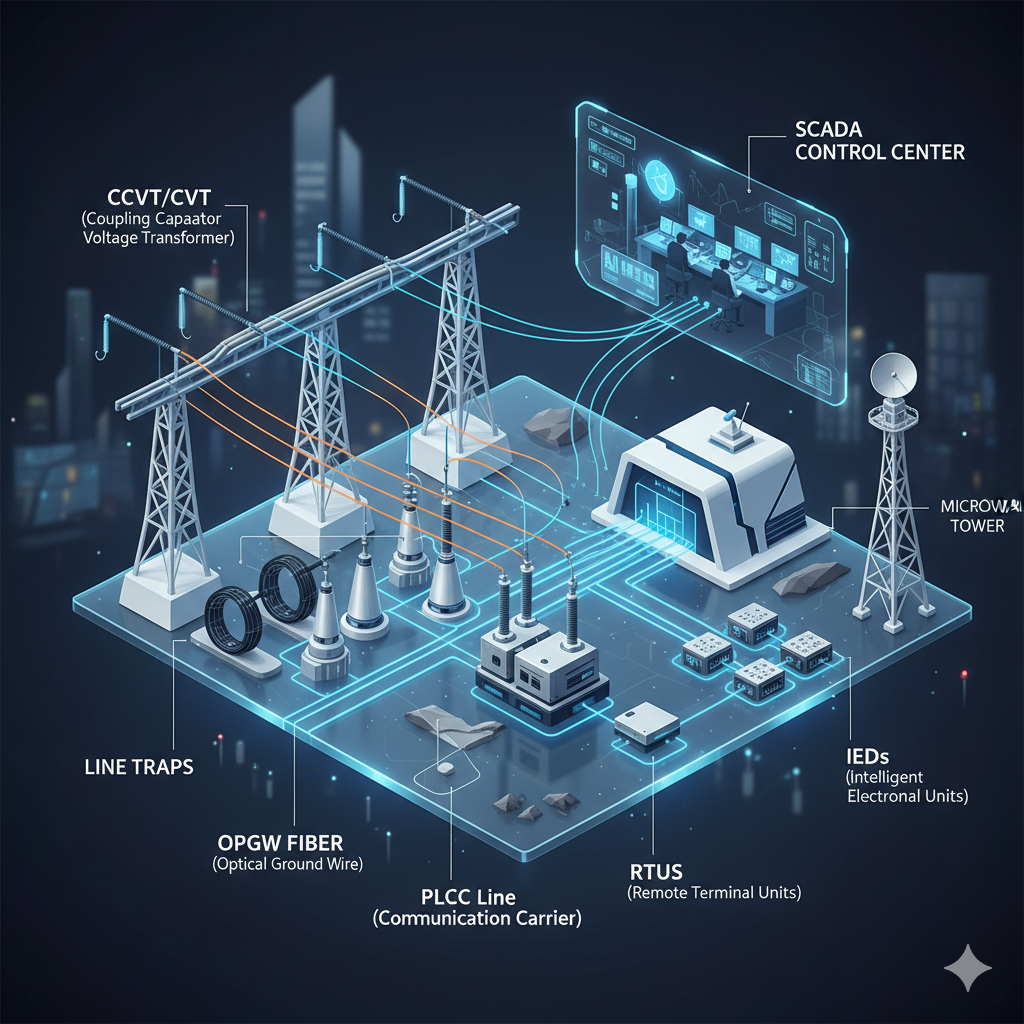
Modern power systems rely heavily on fast, reliable, and secure communication. As the voltage level increases—particularly at 220 kV and above—the need for seamless communication becomes even more critical. High-voltage grid stations must coordinate protection systems, exchange real-time data, and ensure operational safety across long distances.
To achieve this, utilities use a range of specialized communication components. In this article, we’ll explore the major communication systems used in 220 kV and higher-level substations, along with a clear explanation of the role each component plays.
1. Power Line Carrier Communication (PLCC)
PLCC is one of the oldest yet most reliable communication methods used in high-voltage networks. It works by transmitting high-frequency signals over the existing transmission lines.
Why it matters:
- Facilitates teleprotection signals between substations
- Supports voice communication for field staff
- Enables SCADA data exchange without additional communication lines
Despite the rise of optical fiber, PLCC remains widely used, especially as a backup channel.
2. Line Trap (Wave Trap)
A line trap is installed in series with a transmission line and plays a vital role in PLCC systems.
Its purpose:
- Prevents carrier signals from entering unwanted parts of the network
- Ensures proper routing of communication signals
- Allows power frequency (50/60 Hz) to pass without interruption
By blocking high-frequency waves, the line trap helps maintain signal clarity during communication.
3. Coupling Capacitor Voltage Transformer (CCVT)
A CCVT (also called CVT) is used both for voltage measurement and as a coupling device in PLC communication.
What it does:
- Couples high-frequency signals to and from the transmission line
- Provides voltage feedback for protection relays
- Helps regulate and route communication signals
CCVTs are essential interface points between the grid and communication equipment.
4. Line Matching Unit (LMU)
The LMU sits between the PLCC terminal and CCVT.
Role in the system:
- Matches impedance between the communication equipment and transmission line
- Ensures minimal signal loss and maximum efficiency
- Protects PLCC terminals from high voltage surges
Essentially, it tunes the communication path for optimal performance.
5. Teleprotection Equipment
Teleprotection systems ensure that faults on high-voltage lines are detected and cleared within milliseconds.
Why it’s critical:
- Sends signals for Direct Transfer Trip (DTT)
- Supports permissive and blocking schemes in distance protection
- Enhances coordination between substations
Without teleprotection, fault clearance would be slower, risking damage to equipment and system stability.
6. Optical Fiber Ground Wire (OPGW)
OPGW is a ground wire embedded with optical fibers, typically installed at the top of transmission towers.
Key advantages:
- Immune to electromagnetic interference
- High bandwidth for SCADA, protection, voice, and data
- Provides extremely reliable communication between grid stations
Today, OPGW is the primary communication medium for modern high-voltage systems.
7. Digital Multiplexers (SDH/MPLS/PDH)
Multiplexers combine various communication signals into a single channel for efficient transport.
Their role:
- Carry protection signals, voice traffic, and SCADA data
- Provide redundancy and failover capabilities
- Maintain communication even during equipment failure
Modern substations rely heavily on MPLS-TP and SDH for robust network management.
8. Remote Terminal Units (RTUs)
RTUs act as communication gateways between field devices and the control center.
Main functions:
- Gather data from meters, relays, sensors, and breakers
- Transmit data to SCADA systems
- Receive remote commands for switching operations
RTUs are essential for real-time system monitoring.
9. SCADA System
SCADA (Supervisory Control and Data Acquisition) is the heart of grid communication and control.
Why SCADA is indispensable:
- Provides operators with real-time visibility
- Enables remote control of breakers and isolators
- Logs events, alarms, and system health information
- Supports fault detection and preventive maintenance
SCADA integrates all communication devices into one centralized platform.
10. IEC-61850 IEDs
In modern substations, Intelligent Electronic Devices (IEDs) communicate over Ethernet using IEC-61850 standards.
What they offer:
- High-speed messaging through GOOSE and Sampled Values
- Reduced copper wiring and improved reliability
- Seamless interoperability between equipment manufacturers
IED-based automation is the standard for next-generation grid stations.
11. Microwave Communication Links
Microwave systems act as secondary or backup communication channels.
Benefits:
- Useful when fiber deployment is difficult
- Provides dependable data and voice communication
- Ensures redundancy for critical protection signals
Many utilities use microwave as an alternative path for emergency conditions.
12. Network Switches and Routers
These devices form the backbone of the substation’s Ethernet-based communication network.
Their role:
- Manage data flow between IEDs, RTUs, SCADA servers, and protection systems
- Provide VLAN segmentation, redundancy (RSTP/PRP/HSR), and cybersecurity
- Ensure high-availability performance for protection signals
They serve as the central nervous system of digital substations.
13. GPS Time Synchronization System
Accurate time synchronization is essential for event recording and system coordination.
Why it's needed:
- Ensures time-stamping accuracy for relays and SCADA
- Supports synchrophasor measurements (PMUs)
- Helps investigate disturbances with precise logs
Without synchronized time, analyzing faults becomes extremely difficult.
14. Substation Battery and DC System
All communication and protection systems rely on a dedicated DC supply.
Key purposes:
- Provides reliable power during outages
- Ensures communication and protection remain operational at all times
- Supports critical loads such as relays, SCADA, and teleprotection
Even a short loss of DC supply can compromise grid stability.
Comparison of OPGW Fiber and PLCC System as
| Feature | OPGW Fiber | PLCC System |
|---|---|---|
| Speed | ⭐⭐⭐⭐⭐ | ⭐⭐ |
| Reliability | ⭐⭐⭐⭐⭐ | ⭐⭐⭐ |
| EMI Immunity | Excellent | Good |
| Best Use | Protection + SCADA | Backup + Teleprotection |
| Bandwidth | High | Low |
Conclusion
Communication is the backbone of modern high-voltage transmission systems. At 220 kV and above, a coordinated combination of PLCC, OPGW, teleprotection, SCADA, network devices, and synchronization systems ensures that the grid operates safely, efficiently, and intelligently.As substations continue to evolve toward full digitalization, these communication components will remain essential for maintaining a stable and resilient power network.